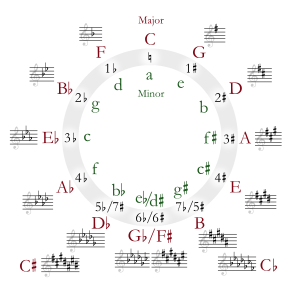G minor facts for kids
 |
||
| Relative key | B♭ major | |
|---|---|---|
| Parallel key | G major | |
| Notes in this scale | ||
| G, A, B♭, C, D, E♭, F, G | ||
G minor is a specific type of musical scale built around the note G. Think of a scale as a set of notes that sound good together. G minor has a slightly sad or serious sound. This is why many composers have used it to express those feelings in their music.
Every minor key has a "relative major" key. The relative major for G minor is B-flat major. G minor is one of only two key signatures that uses a flat but also needs a sharp for its seventh note. The other key like this is D minor.
During the Baroque period, which was a time in music history from about 1600 to 1750, music in G minor often had a key signature with just one flat.
Mozart's Favorite Sad Key
Wolfgang Amadeus Mozart, a very famous composer, really liked using G minor. He thought it was the best key for showing sadness and dramatic feelings in his music. Many of his pieces that sound sad or serious are in G minor. For example, he used it in his Piano Quartet No. 1 and his String Quintet No. 4.
G minor was also the only minor key Mozart used for the main part of his famous symphonies. These include his Symphony No. 25 and the very well-known Symphony No. 40.
In the Classical period, around Mozart's time, symphonies in G minor often used four horns. Two horns would be tuned to G, and two to B-flat alto. Slow movements in G minor symphonies, like Mozart's No. 25, often used E flat major. This was also true for other composers, such as Haydn's No. 39.
Famous Music in G Minor
Many famous classical music pieces are written in G minor. Composers often chose this key for its emotional depth. Here are some well-known examples:
- Fantasia and Fugue in G minor "The Great", BWV 542 by Johann Sebastian Bach
- Symphony No. 83 "The Hen" by Joseph Haydn
- Symphony No. 40 by Wolfgang Amadeus Mozart
- Ballade No. 1 in G minor by Frédéric Chopin
- Polonaise in G minor by Frédéric Chopin
- Piano Concerto No. 2 by Camille Saint-Saëns
- Slavonic Dance No. 8 in G minor by Antonín Dvořák
- Sicilliene, Op. 78 by Gabriel Fauré
- Prelude in G Minor by Sergei Rachmaninoff
- Sonata for Cello and Piano in G minor by Sergei Rachmaninoff
- Most of the Requiem by Giuseppe Verdi, especially the Dies Irae section, is in G minor.
- Concerto No. 2 in G minor, Op. 8, RV 315, "Summer" from The Four Seasons by Antonio Vivaldi
- Adagio in G minor by Remo Giazotto (often called "Albinoni's Adagio")
- Violin Concerto No. 1 in G minor, Op. 26 by Max Bruch
- Christmas Concerto by Arcangelo Corelli
You can also see a List of symphonies in G minor.
Variations of G Minor
Just like there are different flavors of ice cream, there are different "flavors" or versions of musical scales and chords. G minor can be changed slightly to create different sounds or moods. For example, you can add extra notes to a basic G minor chord to make it sound richer or more complex. These changes create variations like "G minor 7th" or "G minor 9th," which are often used in jazz or more modern music.
| Diatonic Scales and Keys | |||||||||||||||||||||||||||||||||||||||||||||||||||||||
|---|---|---|---|---|---|---|---|---|---|---|---|---|---|---|---|---|---|---|---|---|---|---|---|---|---|---|---|---|---|---|---|---|---|---|---|---|---|---|---|---|---|---|---|---|---|---|---|---|---|---|---|---|---|---|---|
|
|||||||||||||||||||||||||||||||||||||||||||||||||||||||
| The table shows the number of sharps or flats in each scale. Minor scales are written in lower case. | |||||||||||||||||||||||||||||||||||||||||||||||||||||||
See also
 In Spanish: Sol menor para niños
In Spanish: Sol menor para niños


